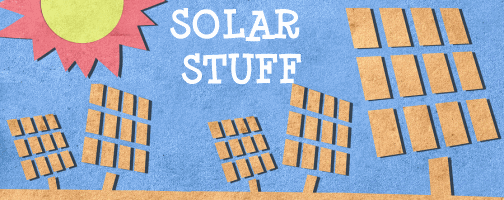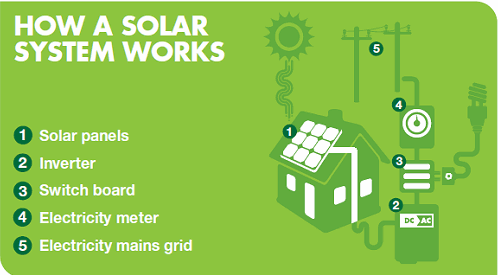At Energy Matters, we want solar to inspire young Australians just as much as it inspires us. That inspiration will help to ensure the good work already being done in moving towards Australia’s renewable energy future continues. In this article we try to explain solar power for kids and teens as it is vital to your future.

We’ve assembled a few interesting educational resources and trivia on this page. We hope you enjoy them and it gets you thinking about pursuing a career in renewable energy!
How many solar panels to power your home?
Use the calculator below to see an estimate of how many solar panels you would need to generate enough power to supply all the electricity use in your home.
How does home solar power work?
The following image shows how a ‘grid connect’ solar power system works. With a grid connect system, you still connect to mains power. The grid supplies your home at night and other times when the solar panels aren’t generating enough electricity. That is, unless you have a solar battery. In that case, that battery can supply your needs when the sun is not shining.
- The sun shines on the solar panels, generating “DC” (Direct Current) electricity.
- The electricity is fed into a solar inverter that converts into “AC” (Alternating Current) electricity.
- The AC electricity powers appliances in your home.
- Any power not required by your home goes via your home’s switchboard into the mains power grid for others to use.
In a way, the mains power grid acts as a “bank”. You export excess power to the mains grid and you take power back when needed.
Energy 101: Solar Power
The following video isabout the different types of solar devices and how they work. It also explains the advantages and disadvantages of solar power.
How A Solar Panel Converts Sunshine To Electricity
Solar panels absorb energy from the sun in the form of photons and transform it into clean electricity.
How A Solar Panel Is Made
‘From sand to solar’. That is how leading panel manufacturer REC explains the manufacture of its solar modules.
Solar power trivia
- The Earth receives more energy from the sun in an hour than the entire world uses in one year.
- In 1839 Alexandre Edmond Becquerel discovered the photovoltaic effect. This effect explains how electricity generation from sunlight is possible.
- In 1941, Russell Ohl invented the solar cell. This was shortly after the invention of the transistor. The transistor has transformed the availability, cost and size of electronic hardware.
- It would take far less than 1% of the Earth’s land area covered in solar panels to supply all of the world’s electricity needs.
- If all the rooftops in Australia had solar panels, it would supply all the nation’s electricity needs.
- Weight for weight, silicon solar cells generate the same amount of electricity over their lifetime as nuclear fuel rods. Of course, they are much safer!
- The amount of energy that goes into creating solar panels is paid back through clean electricity production within anywhere from 1-2 years.
- A solar panel can work for decades. Some installed in the 1970’s are still generating electricity .
- Wind is a form of solar power. In explanation, the uneven heating of the Earth’s surface means that warmer and colder air moves to different locations.
That’s it for our introduction to solar power for kids and teens. Please explore the rest of our site for more information. There’s heaps of it!
Our professional solar installers in Melbourne will assess and determine your energy needs. We customise a solar panel system in Melbourne to fit the roof size of your properly, ensuring you receive the most suitable a solar panel system for your Melbourne home, meeting to property’s energy requirements.







































